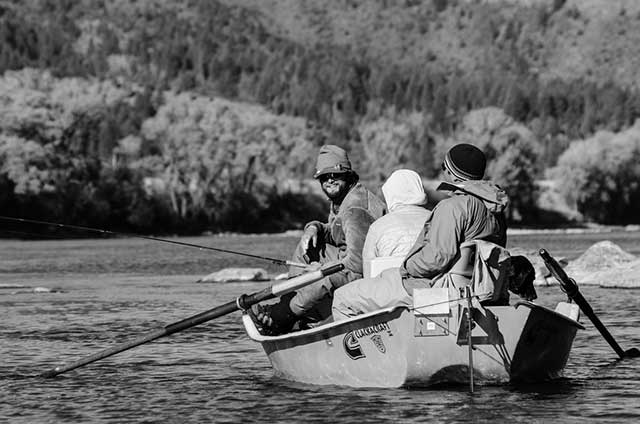When You’re Not the Only One

Gordon Hight photo
Maybe you get to the water late and find yourself working behind another angler—or anglers. Or maybe winter temps bump up to above freezing for the first time in weeks, sending everyone to your favorite steelhead river and forcing you to fish above and behind other sets of boats. In those circumstances where there’s no place else to go, there are still things you can do to help minimize the effects of fishing in others’ wakes—and putting yourself back in a position of advantage.
Steve Cornetet guides the upper Pere Marquette, which presents the double challenge of a busy waterway and wild, wary fish. “I like to be either the first boat or the last,” Steve explains. “Being the first has obvious advantages. You can move quickly, fishing the best holes, picking off active fish, staying ahead of the pack. But once that first boat passes me, that’s where I start fishing as slowly as possible. I fish fewer spots, but I fish them longer. And I don’t move on after I’ve caught a fish. I’ll hang around till I hook up with two or three.”
The streamer angler can also benefit from a modified game plan for those busy days on the water. At such times, finding the best fish can be less about “reading the river” conventionally and more about understanding the path that boats are likely to take through a given stretch of water—and where the fish in direct line of the traffic are likely to be pushed to. Fish will often be routed to low-tier holding lies that don’t have much to offer—save for respite from sloshing oars. These lies might not be a spot that would hold fish on a river empty of anglers. They may not align with your understanding of river hydraulics or even your sense of angling decorum. But on high-traffic days, they just might be where a big brown goes to get a little relief. Find them. Fish them.
Let’s turn our attention to the small stream wading angler. Charlie Piette has spent the past decade guiding on the technical spring creeks of Southwestern Wisconsin. His first bit of advice is to identify the secondary holding water—the “B” spots.
“‘B’ spots may not hold as many fish, but they don’t see the same pressure as ‘A’ spots, either,” says Charlie. “Average anglers go right to the most obvious holding water and walk right by those secondary lies. I can think of dozens of tiny spots on various creeks that are good for just a fish or two, but good none-the-less. Finding all these little hidy holes comes with a firm sense of knowing the water. The fish in these spots are often less spooked, too. They don’t turn off as long when someone walks by. Those fish in ‘A’ spots, the ones that have been nymphed to for hours already, are going to take longer to recover.”
“Being a more efficient angler is important, too. Pressured fish will not typically move as far for a fly. If you’re nymphing, be competent and change your weight, indicator height and flies. This can mean making adjustments at every pool. Most of the time just weight and height is enough, but sometimes fly size helps, too. You don’t want the cannon ball in a shallower pool. To summarize the point here, do what needs to be done to hang the bugs right in their face. Not being complacent with your rigging can make a huge difference.”
Mat Wagner also commented on the importance of resting water whenever possible. It doesn’t need to be a half hour. “5 minutes can make a real difference,” he said. And when all else fails? “Try ticking them off. Even with fish that have been fished over all day long, you can still trigger a territorial response by stripping an oversized streamer through the hole.”
Fishing pressured water involves a new set of calibrations. There’s the water, and there’s the less-pressured water. Understanding your competition is also important. What is the average angler likely to be throwing this time of year? A size 8 Chernobyl? If so, try something smaller and more subtle—a size 12 Letort hopper. More than anything, you’ll need a different mindset. You’ll need to step to the back of the batters box, dig your cleats in deep, and really work the count. Work patiently and with confidence, and you just might turn an overly busy day into an overly fishy one.











